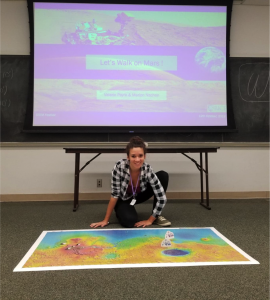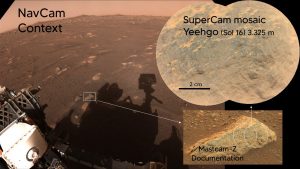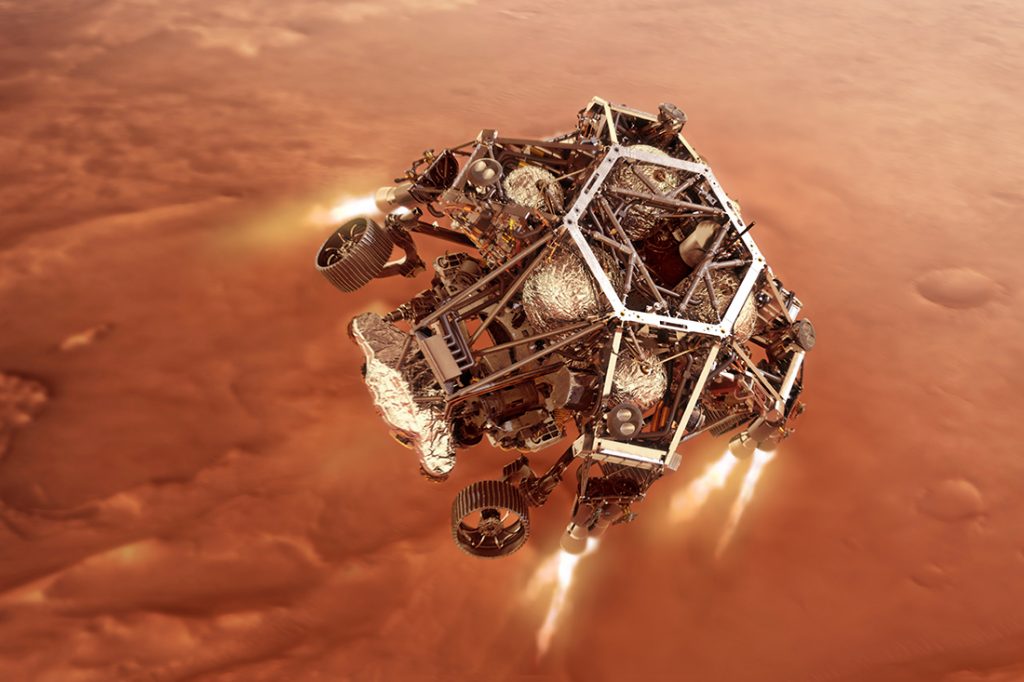On Feb. 18, the world watched as the Mars 2020 Perseverance rover landed on Mars and started exploring Earth’s closest neighbor. For scientists who have spent their lives researching the Red Planet, the seven-minute descent from the top of the Martian atmosphere to the safe landing on the surface was a stomach-churning combination of fear, nerves, hope and exhilaration.
NAU News spoke to researchers out of the Department of Astronomy and Planetary Science and their collaborators at the U.S. Geological Survey about the nail-biting moments as Perseverance approached the surface and the potential this work has for moving forward the conversation about life on Mars.
- Valerie Payre, postdoctoral scholar in NAU’s Department of Astronomy and Planetary Science
- Kenneth Herkenhoff, research scientist at the U.S. Geological Survey
- Lauren Edgar, research geologist at the U.S. Geological Survey Astrogeology Science Center
- Ryan Anderson, physical scientist at the USGS Astrogeology Science Center
- Mark Salvatore, assistant professor and associate department chair, NAU’s Department of Astronomy and Planetary Science
What were your thoughts as the rover was beginning to approach Mars and landing day?

VP: I was really excited, especially on the d-day! I was thinking about a new rover landing on Mars and how she will revolutionize geology and astrobiology through all the campaigns the great science and engineer teams are preparing. Each instrument team has been working super hard to have all instruments ready for this, it took them more than 10 years! So, I was really nervous about how the landing was about to go. From the moment we knew that the rover entered Mars’ atmosphere, I froze and just watched super nervously each step toward landing, being more worried at each stage completed. I couldn’t even talk or eat the Martian cookies my spouse and I cooked for the occasion.
RA: I was really busy getting some last-minute things done to help the SuperCam team prepare for landing, so I didn’t have a lot of time to stop and worry. I was of course reminded of what it was like in 2012, when the Mars Science Laboratory Curiosity rover landed in Gale crater, and how different it would be to experience the landing remotely rather than with the whole science team together in-person at the Jet Propulsion Laboratory (JPL). (SuperCam is one of the primary scientific instruments on the Perseverance rover. Its job is to investigate the composition of materials on Mars’ surface using a combination of laser-induced breakdown spectroscopy, or LIBS, Raman spectroscopy, and reflectance spectroscopy.)
LE: I was nervous and excited! Landing on Mars is an extremely risky endeavor. Recognizing how much work had gone into designing, building and operating that spacecraft made those moments feel even more tense. I was optimistic, but holding my breath during the landing sequence!
KH: I wasn’t too nervous on landing day until the telemetry from the spacecraft showed that it had entered Mars’ atmosphere. Then, of course, the vehicle has to automatically execute many commands on its own, as it is too far from Earth to “joystick” even though the radio signals travel at the speed of light. If any one of many critical activities is not performed correctly, the mission would fail. Very scary!
MS: I had total confidence in the engineers at NASA who designed the landing systems and tested all of the different hardware and software that was necessary to ensure a safe landing. I’ve learned over the years to not doubt their brilliance or their rigorous testing techniques, so I was watching along with the rest of the world with a big smile on my face waiting for the first images to come back to Earth!
What was your initial reaction when Perseverance landed and started transmitting data?

VP: When Perseverance finally landed, oh my goodness, it was just a feeling of joy, liberation, excitement! All the worries vanished, just like that—she did it! She landed in the most dangerous terrain ever faced by a mission! The technology behind this milestone is incredible, and I am impressed and so grateful for this magnificent accomplishment. I am a French citizen, working in the U.S., and I cannot express how inspiring this landing is and how much NASA impresses me mission after mission, especially in the pandemic.
RA: Relief that we landed safely, awe that I get to be a part of such an amazing mission, wonder at seeing a new place on Mars for the first time and that everything worked as well as it did. It is a rare and special experience to study a landing site in great detail from orbit, and then suddenly you’re on the ground and the rover is seeing all of those familiar hills and craters from a new perspective. It makes the place seem so much more “real” to see it from the ground. I was lucky enough to map Gale crater ahead of the Mars Science Laboratory Curiosity rover landing in 2012, so this is my second time having that experience, and it’s exhilarating. I’m reminded every day of how lucky I am.
I was not fully aware of all of the awesome cameras that were on the spacecraft to record entry, descent and landing, so when we started to get bits and pieces of the spectacular landing videos back, I was blown away. I remembered a similar feeling from shortly after Curiosity landed and we started getting descent images from MARDI (the Mars Descent Imager on the Curiosity rover, which returned still-frame images acquired during the rover’s descent to the surface). Every new batch of data takes your breath away again. And likewise with the first data from the science instruments. This mission has some amazing cameras and other instruments, and it’s so exciting to see them working in their natural habitat.
LE: I was elated. It gave me all the feels, and I teared up a little—such joy, such a relief, so much excitement and anticipation for what is to come from this mission. Seeing a new place on another planet for the first time—it never gets old!

KH: Of course, I was relieved and happy when “touchdown confirmed” was announced! In that moment, it became clear that the landed mission would likely be successful and that I would be busy helping to plan and implement Mastcam-Z observations of a place on Mars that nobody has seen up close before. (Mastcam-Z is the primary color and multispectral imager used for scientific investigations on the Perseverance rover.)
MS: I was surprised at how quickly Perseverance started returning data to the Earth. It was great to see the geologic nature of a new location on the martian surface. In the days following the landing, as more and more images and videos were downlinked, it was extremely exciting to see what this landscape looked like from the ground. Prior to this, I had studied this location for more than five years using only data acquired from orbit. It felt a bit like setting foot in an apartment or house that you rented based only on the photos posted on the Internet!
What should the general public take away from the successful landing of this rover? What are the broader implications of what’s to come?
RA: I hope Perseverance stands as proof that humans can achieve anything when we work together. We as humans can look up at a red dot in the night sky and wonder, “What is it like on that planet? Was it ever like the Earth? Was there life there?” Then, instead of being stuck wondering forever, we can work together to go there and find answers. Our universe is knowable. One of the greatest contributions of a mission like this is to share the joy of discovery, of asking questions and finding answers just because we can.

More specifically, this mission is the start of a campaign to return carefully selected samples from Mars to Earth, where they can be studied in greater detail than anything that can be done with a rover. To really be able to answer the question of whether life ever arose on Mars, we need to be able to look at pieces of Mars in the laboratory.
VP: We can all be proud of this. Without the public, I don’t think there would have been enough funding for such a mission, and without all the scientists and engineers from all over the world who worked so hard to make this mission real, this milestone would have never happened. Like the Curiosity rover before, the successful landing of the Mars 2020 mission emphasizes how we can achieve any goals when working all together. Especially in these challenging times, the successful landing enlightened our routine and highlighted how humanity can go beyond any obstacles, together.
LE: I hope everyone recognizes what an incredible achievement it is to send spacecraft safely to Mars. And Perseverance is not alone—a week prior to the Perseverance landing the UAE Hope Probe and China’s Tianwen-1 spacecraft successfully arrived in Mars’ orbit. It’s a good reminder of the international cooperation that is required for space exploration, and I’m looking forward to more coordinated observations among these various missions! And one of the takeaways is we have a new, highly capable rover on the surface of Mars and we are guaranteed to learn something new about the planet.
KH: Even though Perseverance is similar to the Curiosity rover, several bold new capabilities have been added. During the descent to Mars, Perseverance used Terrain Relative Navigation (TRN) to steer the vehicle to a safe landing zone using an onboard digital map of Jezero crater generated by the USGS Astrogeology Science Center in Flagstaff. If TRN had failed, the mission would probably not have been successful. But it was worth the risk because it allowed the rover to target a smaller area that included landing hazards. This capability can now be confidently used to direct future landers/rovers to interesting places on Mars and hopefully return the samples that Perseverance intends to cache on the surface.
MS: The Perseverance rover is the first of three mission phases associated with the Mars Sample Return (MSR) architecture, which is

designed to collect samples from the martian surface and return them to Earth for scientists to study. Perseverance will collect, cache, and deposit these samples on the martian surface, where a subsequent rover will pick them up and launch them back into orbit around Mars. The last phase of MSR will be a satellite that collects these samples from Mars’ orbit and returns them to the Earth. So, the success of Perseverance and all of the interesting samples that it analyzes and collects will be critical for helping us to understand the geologic context of these materials that will eventually be returned to Earth. This is, by far, the biggest step in our ability to understand whether Mars ever hosted life at or near its surface, and what the environmental conditions were like when these samples formed.
What does the successful landing of this rover mean for Mars science and for our understanding of the solar system more generally?
VP: This mission will provide keys to unanswered questions regarding the geology and life on Mars. For example, a set of evidences points out volcanic rocks with compositions looking like those of rocks from terrestrial continents. The Perseverance rover might find additional evidence and provide new insights into what these rocks really represent: Are they remaining of continents on Mars? In addition to enlightening Mars’ history, it would give essential insights into the early geology of the Earth and other planets.
RA: This mission will look for evidence of past life on Mars, and help us understand the history of water at Jezero crater, which will tell us about the history of water on Mars more generally. And the mission is the first step toward sample return.
LE: Perseverance’s landing site in Jezero crater is one of the best places that we’ve identified on Mars to look for evidence of organic matter. Jezero crater hosts an ancient delta and lake deposits. On Earth, deltas are a great place to not only preserve organic matter but to concentrate it. Hopefully Jezero will teach us about past habitability on Mars. This mission is also critically important as the first step in Mars sample return. Knowing the samples collected by Perseverance might one day be returned to Earth and we might get to see them someday just adds so much more significance to these investigations and what they can tell us about the evolution of the planet and the past environments that it hosted.
VP: An essential objective of this mission is to sample rocks that will be returned to Earth. This crucial mission will answer questions about whether life existed or exists on Mars, in which form, and in which context. Finding reliable traces of life on Mars could revolutionize the way we imagine how life appeared and evolved on Earth. Not finding life on Mars would rather provide a non-life end-member for astrobiology and answer questions like what kind of environmental conditions would not favor the development of life in planetary bodies. Regardless of what the Perseverance rover will find, this mission will provide essential clues regarding its own geological/astrobiological history and of other planets.

KH: Returning samples from Mars to Earth has long been the goal of the planetary science community, because they can then be analyzed by complex, state-of-the-art laboratory instruments that cannot be sent to Mars. Better yet, the samples will be analyzed using techniques and instruments that have not even been invented yet, allowing major advances in our understanding of the geologic and possibly biologic history of Mars.
MS: All evidence points to Mars being a more “Earth-like” planet earlier in its history. If life ever arose elsewhere in our solar system (not just on the Earth), then the ancient geologic record of Mars is one of the best places to possibly look. Perseverance’s exploration of Jezero crater will help us to better understand the potential for habitable environmental conditions on another planet, which has broad applications for biology, ecology, geology, and many more fields.
What has been the coolest return from the rover so far?
RA: That’s easy: the videos from the landing! Those videos are among the most amazing things that I’ll ever see.
VP: There are plenty of very cool returns from the rover. I am still amazed by the first images of Mastcam-Z with these super blocky terrains surrounding the rover. She managed to land safely with these very dangerous rocks right next to her! I think my personal excitement is the first SuperCam spectra obtained with laser induced breakdown spectroscopy. I worked and work on the ChemCam data from the Curiosity rover—the father of SuperCam—and seeing the first SuperCam spectra coming out from another location on Mars was mind-blowing for me. I have seen plenty of these spectra, and this one is not particularly special, but it is way more resolved and obtained from a new rover on a new terrain! That is very exciting and promising for the rest of the mission! Go Percy!
LE: Images and video from the entire landing sequence are just jaw-droppingly awesome. The Curiosity rover used a similar approach, but we didn’t have video of the event, so you had to imagine what it would have been like for the rover. Video showing the Perseverance rover lower to the surface from the sky crane brought the entire sequence to life. I still can’t believe this entry descent and landing process works so well! I was also amazed by the first sounds from Mars acquired by the microphones. Hearing the wind sweeping across the surface gave me the chills. I can’t wait to see what’s to come from this mission!
KH: I’m a planetary scientist, but I’ve always been interested in engineering, so the coolest data returned from the rover so far were the videos acquired during descent and landing. They showed the parachute deploying and the rover being lowered onto the Martian surface during the “sky crane” maneuver—awesome!
MS: Definitely the landing video. Landing the rover on the surface of Mars is something that has always felt like “magic” in the past, but the Perseverance landing videos clearly show that it isn’t magic, but instead the result of hard work and flawless engineering from the NASA engineers and mission designers. Absolutely incredible and breathtaking stuff!
Above illustration: NASA’s Perseverance rover fires up its descent stage engines as it nears the Martian surface in this illustration. Credit: NASA/JPL-Caltech.



